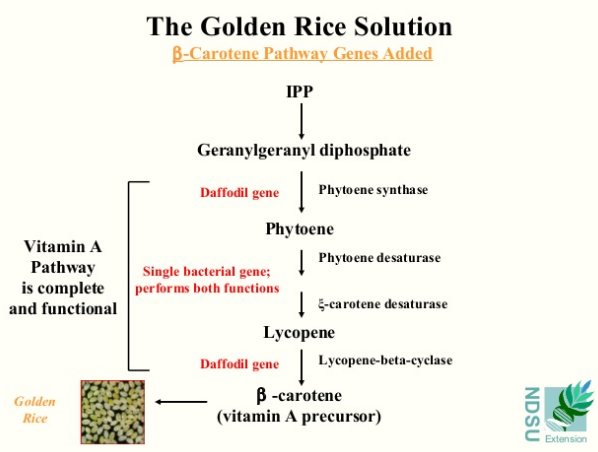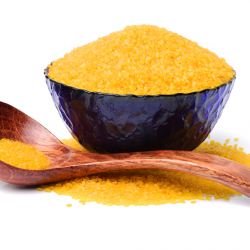Vitamin-A deficiency around the world leads to between 250,000 and 500,000 children going blind – every single year. Half of them die within a year of losing their sight. And several other health problems stem from this urgent issue.
Yet, a solution to this global health threat is available today, and it could quickly help 250 million preschool children around the world who are vitamin-A deficient, as estimated by the World Health Organization.
That said, exactly how many countries today are growing "Golden Rice" – a genetically-modified seed with three genes that produce beta-carotene, a vitamin-A precursor – to assist their underfed and vulnerable populations?
Zero.
Yes, it's difficult to fathom, that an effective tool for improving health and battling starvation on a global scale – one that's been available since 1999 and backed by more than 100 of the world's most distinguished scientists – is still not being used.
"ON THE HORIZON"
We learned of zero acceptance to date by researching recent reports and studies from leading organizations and experts in this field. And it appears that right now just two countries – Bangladesh and the Philippines – are making strides to begin utilizing Golden Rice seeds in the near future. But they're not there yet.
One study that examined its development and worldwide reputation, titled "Disembedding grain: Golden Rice, the Green Revolution, and heirloom seeds in the Philippines," was first published in March 2016 but updated and reissued in the journal Agriculture and Human Values in March 2017. In it, the authors wrote that "the release of Golden Rice is on the horizon only in the Philippines, a country with a storied history and complicated present, and contested future for rice production and consumption."
That meshes with an estimate from another expert from the International Rice Research Institute, or IRRI. Referring to the viewpoint of former director Robert Zeigler, World-Grain.com, which reports on the industry, states "Golden Rice remains unavailable to rice growers anywhere in the world, and experts estimate it will be at least a couple of years before it will be available, probably starting in the Philippines." And according to Zeigler, "large-scale trials in farmers’ fields would likely be in place in about 2019, with commercialization coming somewhat later."
Meanwhile, the Genetic Literacy Project, a close and reputable follower of the GM-movement, reported May 9 that "Bangladesh is close to rolling out a disease resistant potato, vitamin A-enhanced rice and insect resistant cotton, among other new crops," and "it appears that commercialization may begin in 2018."
Not only does the lack of vitamin A cause blindness, over time it also undermines the immune system to such an extent it's estimated that two million people die annually of diseases that would otherwise be survivable. In addition, the condition greatly worsens the impact of diarrhea and the measles.
 It's been nearly a quarter century since research began on this topic, and more than 15 years since European professors Ingo Potrykus and Peter Beyer produced the vitamin-enriched grain.
It's been nearly a quarter century since research began on this topic, and more than 15 years since European professors Ingo Potrykus and Peter Beyer produced the vitamin-enriched grain.
These academic scientists found that in order to give Golden Rice the ability to make beta-carotene, three genes needed to be added to the embryo of the rice. Two of the genes come from daffodil and one from the bacterium Erwinia uredovora. The genes produce proteins that convert the precursor, IPP to beta-carotene. (The pathway is detailed in the adjacent graphic, courtesy North Dakota State University.)
WHAT'S THE HOLDUP?
So given all this time, what explains the lack of acceptance worldwide?
Is it that Golden Rice is unaffordable to the impoverished countries that would benefit from growing the crop? No.
"Syngenta, the biotechnology company that developed Golden Rice, has given up its intellectual property rights on Golden Rice as a humanitarian initiative," adds World-Grain.com. "Farmers wouldn’t have to pay more for Golden Rice seed, and the IRRI has been given a free hand by Syngenta to work with the technology."
Is it because the scientific community is unsupportive of the genetically-engineered product? Also, no.
In fact, last June more than 100 Nobel laureates strenuously defended the science by signing a letter addressed to Greenpeace, condemning that organization for its longstanding and rabid anti-GMO position.
"We urge Greenpeace and its supporters to re-examine the experience of farmers and consumers worldwide with crops and foods improved through biotechnology," they wrote in part, "recognize the findings of authoritative scientific bodies and regulatory agencies, and abandon their campaign against GMOs in general and Golden Rice in particular.”
UNCERTAINTY & FEAR
For countries with rice-based diets that could greatly benefit from this enriched grain, particularly those in Southeast Asia and sub-Saharan Africa, the lack of acceptance boils down to two beliefs: uncertainty and fear.
As mentioned, Greenpeace has been a major scaremonger and leader in sowing doubt. Leveraging its drastic opposition to all genetically-modified foods, the activist group has successfully advanced the Trojan Horse argument that if Golden Rice is allowed to take root then the door will be open to GMOs of every stripe.
Other countries, like Thailand, that are heavily invested in rice importing and exporting, have had concerns about whether the growing of GM-rice would spread to the conventional crop. India, which is influenced by the European Union, has adopted its anti-GM thinking. And several years ago in China, researchers involved with Golden Rice reportedly committed an ethical breach by feeding the grain to children without informing their parents first. When it became public, China shut down the research, drastically undermining Golden Rice's reputation.
Supporters who know and trust the science are hopeful that other governments will quell any potential fear and embrace the life-saving benefits of Golden Rice. After Bangladesh and the Philippines, "[o]ther countries that may follow suit include Indonesia, Malaysia," states World-Grain, and "Colombia in Central America and Haiti, a Western Hemisphere country known for its poverty."

